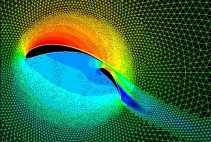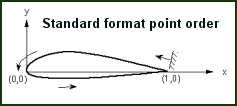UIUC Airfoil Data Site
The UIUC Airfoil Data Site is a collection of airfoil coordinates
and airfoil related links. The UIUC Airfoil Coordinates Database includes the airfoils, and they
cover a wide range of applications from low Reynolds number
airfoils for UAVs and model aircraft to jet transports and wind
turbines. Originally the site included mostly low Reynolds number
airfoils (about 160), but in December 1995 the site was greatly
expanded when David Lednicer of Analytical Methods, Inc.  contributed his airfoil collection. This addition brought the total number of
airfoils to over 1000. Since this time, the number of airfoils has
expanded to include over 1600, and more will be added as they become
available. Currently, the airfoils are listed in alphabetical order by
the file name, which most often is the airfoil name or close. You can
browse the directory, but it is suggested that you use your
web-browser "find" button to search for keywords. For questions, see the Airfoils FAQ.
contributed his airfoil collection. This addition brought the total number of
airfoils to over 1000. Since this time, the number of airfoils has
expanded to include over 1600, and more will be added as they become
available. Currently, the airfoils are listed in alphabetical order by
the file name, which most often is the airfoil name or close. You can
browse the directory, but it is suggested that you use your
web-browser "find" button to search for keywords. For questions, see the Airfoils FAQ.
Airfoil Format
For reference, the original airfoils in the list and new ones added by Selig are in an x,y format starting from trailing edge, along the upper surface to the leading edge and back around the lower surface to trailing edge (e.g., see E205). Lednicer's contributions are upper surface points leading edge to trailing edge and then lower surface leading edge to trailing edge (e.g., see Clark Y). Some of the airfoils listed do not close at the trailing edge, i.e. the trailing edge has a finite thickness as designed.
Airfoil Contributions
If you would like to contribute airfoils to this site, please email them to m-selig@illinois.edu. Selig's x-y format (standard format) is preferred. Please include a description of the airfoil and also identify the source. Typically, this description will be reduced to a few words in the database. Valuable contributions would include airfoils that have received some notoriety (good or bad), been used on a particular aircraft and/or been published in some form such as a magazine, conference paper, journal or book. Those contributions thought to be of general interest will be added. Updates to the list will occur infrequently and in batches.
History and Credits
- First, to those people not listed here who have offered useful information to help build and improve the dataset, thank you! Some details are listed in the update history.
- Thanks go to Mark Barton for creating the airfoil plots in gif format for the Version-1.0 dataset. His simple Matlab code for reading the various formats and plotting the airfoils is listed here. The more recent plots were generated using a modified version of his Matlab code.
- Lloyd MacLean's instructions on getting the Selig-formatted airfoils into AutoCAD R14 is here.
- Elodie Roux' Matlab file for reading the UIUC data files. Looks like it only reads the Lednicer format files. Output is a plot if you make the mods mentioned in the file. It also does some splining and determines the max thickness.
- The database also received a big boost from Lawrence Hur and Mike Luman (UIUC undergrads). Thanks!
- The UIUC Airfoil Data Site airfoil logo above was created by Michael Soso using Fluent when he was at UIUC/APA as a graduate student (now with BMW-Sauber F1 Team). Thanks!
- Finally, the coordinate database update
Other Airfoil Data and Information Sites
First, in addition to these below links, there are more links included with the airfoil listing page.
- The Incomplete Guide to Airfoil Usage
- Interested in knowing what airfoils are used on what aircraft? David Lednicer has created here a great compilation of aircraft and the airfoils they used.
- Rhino Plug-In to Import Airfoil Coordinates, and Rhino Script (CAD/CAM software)
-
Dale Fugier, one of the developers of Rhinoceros (Rhino3D), has
written a Plug-In to plot airfoils from the database.
It requires a Rhino 7 or newer, or Rhino for Mac V7 or newer.
See installation instructions.
The plug-in requires that the airfoils be in the
standard format (wrapping from
upper surface trailing edge around the leading edge to the lower
surface trailing edge).
 Separate from the plug-in is a Rhino 7 script.
The script is ImportAirfoil.rvb on github.
Use the Rhino LoadScript command to add and then load the script
into memory.
Then use the RunScript command to run it.
It will then prompt for the airfoil file.
There is also a Python port of the Rhino rvb script here:
https://discourse.mcneel.com/
Separate from the plug-in is a Rhino 7 script.
The script is ImportAirfoil.rvb on github.
Use the Rhino LoadScript command to add and then load the script
into memory.
Then use the RunScript command to run it.
It will then prompt for the airfoil file.
There is also a Python port of the Rhino rvb script here:
https://discourse.mcneel.com/
- AFSMO Airfoil Smoothing Code from NASA (hosted by PDAS)
-
For coordinates that are not smooth, the NASA AFSMO smoothing code (airfoil smoothing code) can be used to smooth the points.
The code removes bad kinks in the airfoil surface curvature that can give rise to spikes (non-smoothness) in the velocity distributions.
The code is fortran.
Added online at PDAS by Ralph Carmichael.
Links are:
https://www.pdas.com/afsmooth.html
https://www.pdas.com/afsmoothdownload.html
Many of the airfoils in the database were smoothed by Selig, and these include 'sm' in the name. Search for "sm.dat" to see them in the database. - Propeller Factory Using UIUC Airfoil Coordinates Database (at Thingiverse)
- Johann Schuster has made a nice python script to produce a propeller geometry using airfoils from the UIUC Airfoil Database (or any other airfoil coordinate file). The propeller geometry can be exported to STL and printed.
- Another Coordinate Importer/Exporter for Rhino (CAD/CAM software)
- Rick Loheed (https://www.islandengineering.com) has written some VBScript for Rhinoceros for importing and exporting airfoil shapes. Drawairfoil.rvb opens a file using the "Selig" format, then fits a through point NURBS curve through the data. The ExportFoilDat.rvb file will 'walk' a NURBS curve, and output the values. The starting point of the curve must of course be the trailing edge and point upward along the upper surface. It is very useful for evaluating airfoils sent in Rhino format, very common to the marine industry. Surfaces may be sectioned to create the curves quite easily. There is a cosine weighted leading/trailing edge scheme in there too, though it may be a bit clunky. XFOIL and XFLR5 did not like it so I took it out.
- Airfoil Coordinates Converter to IGES NURBS Format (by Flusur)
- From Salvatore Dona -- Flusur is pleased to announce its new online converter, capable of converting airfoil dat files to NURBS format. The NURBS format is the IGES Rational B-Spline Curve (Type 126, "IGES 126") of 3-degree. All the CAD software can import it easily.
- XFOIL
- XFOIL is an interactive program for the design and analysis of
subsonic isolated airfoils. It consists of a collection of menu-driven
routines which perform functions such as:
- Viscous (or inviscid) analysis of an existing airfoil.
- Multi-point airfoil design by interactive specification of surface speed via mouse cursor.
- Direct geometric manipulation (flap, camber, contour deformation, etc.).
- Drag polar calculation with fixed or varying Mach and Reynolds numbers.
- Writing and reading of airfoil geometry and polar save files.
- Plotting of geometry, pressure distributions, and polars.
- XFLR5 (https://www.xflr5.tech/xflr5.htm)
- Andre Deperrois re-write of XFOIL in C++, and it includes additions to account for wings.
- Martin Hepperle's Site
- Airfoils, winglets, propellers and more for model aircraft. A really nice site!
- NACA.BAS source code (last update: 8/20/98)
- David Lednicer's NACA airfoil coordinate generation program (about NACA.BAS in Basic). A Win95 version of the executable: naca.exe 145 kb . Before you try running the exe file, read this.
- XFOIL Results for Several Flying Wing Airfoils
- These results come courtesy of Kelly O'Brien - UIUC AAE undergraduate. 1997
- DesignFOIL
- An airfoil analysis code from DreeseCODE Software. It uses the UIUC Airfoil Data Site airfoils among others. It also creates output files in various formats.
- AeroFoil
- A user-friendly airfoil design and analysis program written in Visual Basic. It will generate NACA 4, 5, 6, and 7-digit series airfoils, and import/export airfoil coordinates in dxf format.
- Hanley Innovations
- Aerodynamics software from Patrick Hanley includes - VisualFoil, ModelFoil, WingSections, AirfoilBrowser. Most of these packages make use of the UIUC airfoil coordinates database.
- FoilSim from NASA Glenn Research Center
- A neat NASA web site where you can interactively change the camber, angle of attack and other parameters of an airfoil and watch the resulting flow, pressure, and lift.
- CompuFoil ~3D~
- Airfoil geometry modification and plotting software for foam cutting and rib layout.
- Three-Parameter Family of Airfoils
- As described by Roger Alperin, his Yet Another Airfoil note "describes a 3-parameter family of airfoil curves based on a geometrical construction using a family of circles."



